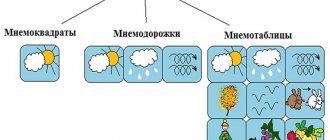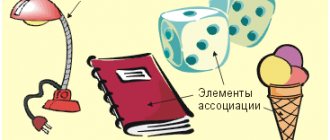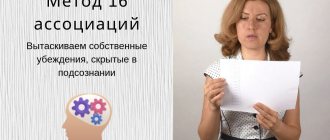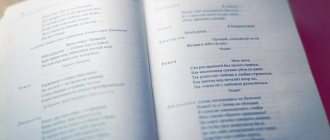Save article:
The article explains:
- Types of human memory
- Mechanisms and types of memorizing information
- Effective methods of remembering information
- Simple exercises for memorizing information
- Top 5 books to improve information memorization
Memorizing information is not a constant value and can be developed, even despite a person’s age. This is a skill that is used throughout life, starting at a very young age. It is simply irreplaceable in study and work, which is why there are various techniques that make it easier to assimilate information and reproduce it in the future.
To develop memorization, you can use several methods or choose one that is most suitable. In our article we will tell you what human memory is like, we will understand the mechanism of memorization and we will provide the most effective methods for developing this skill.
Method No. 1. Method of analogy or association.
Any innovation that is difficult to learn can be learned through association. To do this, it is enough to draw a parallel with some familiar phenomenon or event. Moreover, the established analogy may have nothing to do with the phenomenon being studied. It should be simple, close and understandable directly to the student: an event from his life, a favorite word, etc.
Application of the analogy method in practice
Experienced experts recommend drawing analogies with similar words that are consonant with the term or topic being studied. This technique can speed up the “learning process” by 40-50%, while memorizing information is guaranteed.
This technique is most often followed by people with good imagination, a bright and rich life, who have something to “compare” with a term, object, etc.
Use the Aivazovsky method
Using this method, which is attributed to the famous marine painter, you can connect photographic memory. She will come to the rescue when you need to remember in the smallest detail any view, picture or image of a loved one.
Look at an object, landscape or person for three to five seconds, trying to remember the details. Then close your eyes and mentally imagine the object in the smallest detail. Ask yourself questions about the details of this image and mentally answer. Then open your eyes for one second, look at the object again and complete the image. Squint your eyes and try to achieve the brightest possible image of the object. Repeat the last two steps several times.
Method No. 2. Abbreviation.
An abbreviation is a shortening of words. Today, each of us is faced with various abbreviations every day: IMF, Central Bank of the Russian Federation, CIS, etc. Even schoolchildren, when writing down homework, essentially use abbreviations and the principle of “verbal minimalism” (for example, Russian language exercise 360).
An abbreviation can be presented in different forms: an abbreviation based on the first letters of a word, a saying, where each first or last letter indicates a specific feature (for example, the color of the rainbow), etc.
Using abbreviations to better remember information
Similarly, a student can study subjects. Most often, he uses abbreviations when taking notes on lectures (this is where new abbreviations are born), but why not start learning the subject with the help of them?
Read the topic and then create an “abbreviated version” of it. It is important to note that this technique will allow you not only to better remember the most important things, but also to prepare cheat sheets that will help you out in difficult times or will warm your soul, calming you down during the exam.
Any difficulties?
Need teacher help?
We are always happy to help you!
master's theses
Conditions for effective memorization
To manage your memorization process and achieve good results, apply the following principles:
- do not let this process take its course, use conscious memorization;
- strengthen your memory with special exercises - we have compiled a selection of them in a separate article;
- give up cramming in favor of mnemonics coupled with analytical memorization. For example, first learn all the terms, formulas and definitions of a paragraph through images, and then analyze the text, make a mind map based on it and memorize it again using mnemonics.
- remember that the state of memory is closely related to our general physical condition: a balanced diet, adequate sleep, the absence of stress and bad habits increases the ability to remember even without the use of special techniques.
Method No. 3. We remember visually.
If you have a well-developed visual memory, then try not just to memorize the material, but to remember its location in a textbook, lecture or other primary source. This will not only allow you, if necessary, to quickly find a fragment for a full answer, or copy it off during a test or exam. It is enough to remember on what page it was written, what this page looks like (a crushed corner, old, shabby paper), in which paragraph the information suitable for an answer is located, and how the text will completely appear before your eyes.
Memory technique No. 2. Writing a story or story
This method is easy to use and does not require special skills. Its essence boils down to compiling a story in which the characters will be visual images associated with memorized information.
For example, you need to remember the same shopping list - milk, cheese, loaf, apples, soap. To do this, we are writing a story in which the main characters will be products from our list.
Example: Imagine... You open the door to a store and... here, you are picked up by a wave of a milk river that flows out of the open doors. You miraculously manage to grab onto a piece of cheese floating by. Holding on to the saving cheese, you swim to an unusual island on which, instead of leaves on the trees, loaves grow. You feel hungry, pick up a stone from the ground to try to knock down a loaf, and then the stone turns into a juicy red apple. Are you surprised. Bring the apple to your mouth and want to taste it. You bite and realize that you have a bar of soap in your mouth. Wince. You throw it aside.
This is the story we have. A little crazy, but it gets the job done. We remembered the shopping list.
This method has a peculiarity - the more unusual the story, the better you will remember it. Now about the advantages and disadvantages of this method.
Pros: - easy to use; — does not require special training; - quite versatile. Disadvantages: - large time costs; — limitation in the amount of data to be remembered (for example, a list of 20 or 30 elements will be difficult to remember).
Method No. 4. The method of arranging objects or the “Cicero” method.
If after reading you were unable to remember anything, do not freak out or despair. Try connecting memory and associations at the same time. Remember the environment or room that is familiar to you, imagine that you are in it. And now “put each moment you read into its place” in this room, but this must be done in the order in which you usually walk through the room (out of habit).
The principle of the Cicero method
Let's say you're standing in front of your own bedroom door. The door itself is a theme, you entered and put things on a chair or in a closet (there should be another link to the theme, an introductory note, for example, how it all began, etc.), then you go to the bed and sit down/lie down (here is another link) and etc. And so you need to learn and “rehearse” until you remember everything you need.
Further, if you suddenly forget something during the exam, you just need to remember the usual room and procedure, and your memory will give you the entire text.
Mnemonics: what is it and who needs it?
Mnemonics is a set of special techniques for remembering information. This word has ancient Greek roots, i.e. the art of memorization interested people many years ago. In particular, the well-known public speeches of ancient Greek orators, which gave rise to the science of rhetoric, sometimes lasted more than one hour. How did philosophers, politicians and other public figures keep so much information in their heads? Mnemonics is the key to this riddle [B. Rudenko, 2015].
The methodological arsenal of mnemonics contains a variety of memorization tools: visualization, auditory, kinesthetic representation, modifications, linking and simplification, i.e. everything that helps build associative chains with existing information. Usually, a variety of categories of adults resort to mnemonics exercises, in particular:
- people studying foreign languages;
- students who need to remember a large amount of knowledge when studying;
- workers whose activities are related to numbers and statistics;
- scientists trying to remember as much information as possible and connect it;
- doctors who must remember the medical histories of their patients, their prescriptions;
- programmers who take into account all the details when working;
- people simply suffering from forgetfulness, etc.
As you can see, the need to study mnemonics exercises is present in a variety of professions. But, in fact, these exercises will be useful for any adult, because... the skill of memorization cannot be superfluous even taking into account our daily habits, when we need to buy several types of products, go to several places, remember the names of new people when we meet, i.e. mnemonics are useful for everyone.
And before moving on to specific exercises for developing the memory of adults, we would like to recommend our online program “Mnemonics”, where in 5 weeks you will learn to remember names, faces, addresses, birthdays and much other information correctly and for a long time. Special online simulators and interesting practices will make the educational process easier for you if you are studying at an educational institution or undergoing training at work.
Let's now look at memory exercises for beginner adults.
Method No. 5. Rhyming.
Memorizing poetry is much easier than boring and long text. Why not turn the study of the subject into one large poem with chapter themes? To do this, it is enough to rhyme each term or definition with familiar and everyday words or even rewrite them as poetry (of any composition).
If you are far from writing creative works or poetry, then you can simply link individual concepts to poems already familiar to you. To do this, you need to connect associations or analogies, a little imagination.
Memory technique No. 3. Compiling phrases using the first letters
You are familiar with this technique of memorizing information from school. To remember the colors of the rainbow, you were asked to learn the following phrase: Every Hunter Wants to Know Where the Pheasant Sits. Essentially, this phrase encodes a sequence of colors - Red, Orange, Yellow, Green, Light Blue, Blue, Purple.
This technique has limited use. It is mainly used to remember a sequence of abstract concepts that cannot be represented in the form of visual images. For example, a list consisting of the words: love, happiness, peace, gratitude, respect, is better remembered using this technique. Since these words do not have visual images. In all other cases, it is advisable to use other techniques.
Method No. 6. We encrypt the recording.
If complex terms are difficult to memorize and decipher, then it is worth trying to transform the process of preparing for a test or certification into a children's game - encryption. Remember how you used to correspond with your friends in a language that was incomprehensible to others: you assigned each letter a number or a specific symbol, etc. Why not apply this method here too? Scientists have proven that the form of play activates brain cells, and the feeling of excitement allows you to quickly understand the essence of the matter.
Features of using the encryption method
Students most often “encrypt” information “in their own way.” They look for analogies between numbers and letters, symbols and individual elements. For example, in mathematics there are certain abbreviations (for example, infinity, sum, etc.). Why not use familiar symbols in other objects?
Chunking method (crushing, fragmentation)
This method involves combining several elements that need to be remembered into one small group. Many people use it when trying to remember phone numbers or bank account numbers, but this method can be used for other types of information. The chunking approach is often reflected in the way we write phone numbers - with a dash. We do it this way in order to better perceive a set of numbers and remember them faster. Is there a difference between the perception of a set of numbers: 89265660000 and 8-926-566-0000? Of course have.
The key principle that makes this technique work is the combination of items based on semantic encoding, that is, items are placed into small groups according to context or some kind of pattern.
For example, some may group their grocery list alphabetically, others by food type. In any case, this method is only successfully implemented when you identify the most natural patterns for yourself and follow them.
Method No. 7. Spaced repetition.
Everyone knows that learned material can be “erased from memory” over time if it is not used. This is how the body cleanses itself of unnecessary and useless information, freeing up space for new discoveries and information. Therefore, if you want the learned material to be stored for as long as possible, and preparation for certification to be easy and quick: delve into each topic from the very beginning, and then periodically repeat what you have covered: re-read lectures, seminars, etc.
In this case, preparing for the exam will be easy and relaxed: the author will know everything necessary, he will only have to repeat it, focusing on the most difficult moments for him.
Moreover, experts note that it is necessary to repeat, not just re-reading the data at hand. It is important to try to extract them from memory, and rereading is intended to fill in the identified gaps. Therefore, first try to remember and tell the question, then re-read it and retell it again.
If the topic is too long, it is best to adhere to the following rules of spaced repetition:
- Review the material directly on the day you learn the topic;
- On the second or third day, retell what you taught, re-read the question again and highlight the key points;
- After 5-6 days, repeat what you have learned again, if necessary, read it again.
To better understand the material, it is enough to devote 10-15 minutes to it every day: briefly retelling and quickly rereading lectures or other manuals.
Using an accumulation system: Atkinson's method
But Atkinson is confident that memory should improve gradually, without sudden jumps and overloads. Therefore, the only safe and proven method of strengthening memory is the accumulation method.
The scientist proposes to leave aside all artificial techniques, using only what nature itself has given us. The brain, like all muscles, needs training and gradual loads. As loads increase, memory efficiency will also increase.
This system was actively used in ancient times, when only a select few knew how to use a pen, and wise men could not always trust their secrets
The essence of the system is this:
- Choose a text (optimally in poetic form). On the first day, 4 to 6 lines are learned by heart.
- On the second day, they repeat yesterday’s learned lines and additionally learn 4 to 6 more lines.
- On the third day, 4-6 new lines are added to those already learned.
The greater the number of repetitions, the better the new material is remembered.
It's okay if you peek at the book from time to time. Don’t be upset if you forget something: over time, your memory will increase and memorization will become easier.
After a month, double the amount of information you master. In another month, you can triple the amount of information.
Research has shown that as a result of using this technique:
- learned knowledge remains for a long time and easily emerges in memory,
- the ability to remember absolutely any thing improves all the time,
- With the help of willpower, any information is easily remembered.
The essence of this method is nothing other than repetition. It is better to conduct classes in the morning, since at this time of day our perception is still fresh. Train every day and you will see: within a month your brain will begin to remember many times more information.
Method No. 8. Edge principle.
What information does a person remember most quickly? As a rule, when studying a topic, the initial and final scenes are engraved in the memory, and the middle remains “unconscious”.
If you read the material, but could not completely remember it, do not be discouraged. We are more than sure that the first and last couple of paragraphs remained in our memory. To remember the rest, you need to start learning from those moments that could not be memorized. Just start studying precisely from those fragments that you failed to learn or did not understand.
Types of memory by sensory modality
Depending on which channel is leading in the perception of information, memory is divided into auditory, visual, gustatory, olfactory and tactile
(memory in sensations).
For example, smelling the perfume your first teacher wore can unexpectedly revive a chain of childhood memories. This is the result of the work of olfactory memory. And if you remember the New Year when you eat tangerines, it means the taste has worked.
With rare exceptions, the visual channel is the leading one. But this does not mean that everything else can be abolished. They are good to use as auxiliary ones.
For example, in order to better remember hieroglyphs, you can not only assign similar images to them (mnemonics), but also “draw” features in the air with wide movements of the hand or even the legs and head. This way you use tactile memory - body memory.
Method No. 9. Let's get to the point.
Believe me, if you tell a question or topic in your own words, without intricate and florid book phrases or clichés, then this knowledge will be much more valuable, both for you and for the teacher, who will make sure that the student has understood all the nuances and understands the material , learned it.
Identification of the most significant in the total amount of information
Therefore, when studying any subject or issue, highlight the essence (key aspects of terms, theories, formulas) and learn it. As popular wisdom says, the rest will follow.
Content
- How neural connections are formed
- Remember everything: general recommendations
- Memory techniques
Throughout life, the human brain creates more and more neural connections that a person needs in vital processes:
- production and understanding of speech,
- control over your own body movements,
- formation and strengthening of memory.
When these connections are destroyed, some areas of the brain stop communicating with each other. This makes it more difficult for a person to remember new information.
In this article, you will learn how to approach the study of this or that material correctly in order to forever retain everything you have learned in your memory.
Method No. 10. Feynman's method.
This principle was named after its creator, a theoretical physicist named Richard Feynman, who managed to develop a unique method for storing information. His “law” is based on simplifying complex issues by using simple and understandable words, phrases and phrases.
This rule is implemented in three stages:
- We write out abstracts or create a plan of material that will allow you to briefly and succinctly describe the essence, highlight basic concepts, etc.;
- As the plan is formed, we re-read the material and identify gaps that were not covered in detail in the previous paragraph. It is important to use only simple and understandable words for you;
- Next, we form a simple and understandable full-fledged text, which will describe all the main aspects of the topic being studied. All that remains is to read and retell it, repeating it periodically to reinforce it.
Online trainers for developing memorization skills
Finally, I decided to share with you services for memory training. There are a great many of them on the Internet, a beginner can easily get confused.
Vikium
Vikium is an online platform that contains more than 100 simulators for brain development, more than 10 courses in various fields, and several interesting tests. You can develop memory, attention, thinking, logic, emotional intelligence and much more.
As part of our work on improving memory, you and I will be interested in the Mnemonics course. In 15 lessons, you will learn several effective memorization techniques, practice on special simulators, and consolidate the learned material on testing. The skills acquired in the course will help you memorize up to 100 objects per hour, keep all passwords in mind, easily learn foreign languages and much more.
Bitreynik
Bitreynika is a service with exciting games for developing brain functions. If exercises and simulators seem too boring to you, then games are what you need. They are suitable for both children and adults.
I'll tell you about my favorites:
- Numismatist is a game for developing the speed and accuracy of memory. You will need to memorize and compare coins of different denominations from different countries.
- Sound maker is a task similar to the previous one, only you will have to compare not coins, but different sounds. Auditory memory also needs to be trained.
- Phrasoscope - in addition to speeding up your memory, this game will also help you develop your reading speed. On the screen you will see a line in which some words will be revealed only for a while. Your task is to notice them and write them down.
BrainApps
The BrainApps service is simply a treasure trove of materials on brain development. There are simulators (as many as 52 of them!), developmental courses, interesting tests, problems, as well as a blog with popular science articles.
Practice on the simulators, take a course for memory development. Here you will learn not only to effectively memorize information, but also to retain it in memory for a long time.
4Brain
On the 4Brain platform, unlike the previous three, there are no simulators. But there is a huge selection of courses - both paid and free. And a whole bunch of smart articles and useful books.
Start with the course Memory Development: Memorization Lessons - it is free and available even without registration. On it you will learn about the memory structure, master several techniques and learn how to apply them in practice.
If you like it, you can take an advanced paid Mnemonics course. There is a lot of practice and a well-structured, non-boring theory.
If you like the online course format, you can take a look at our selection of memory improvement courses. There you will definitely find a suitable option.
Recommendations from Dishelp experts on how to assimilate the material as efficiently as possible
When studying and memorizing a large amount of information, it is important to create decent conditions: silence, peace, a minimum of distractions over trifles, allocate separate time for studying the subject, etc. Therefore, turn off all gadgets, warn your family or “roommates” so as not to be disturbed, concentrate in preparation.
Tips for better assimilation and memory of new information
Include all methods of memorizing information that are acceptable to you. Actively use those techniques that correspond to the “type of your memory”: visual, auditory (audio), written. If it’s easier for you to remember by ear, listen to audio books; in writing, take notes on all the questions; visually, use the association method, remember the location of the text in the original source, etc.
Don't give up on repetition. It is this that can not only refresh, but also deepen a student’s knowledge. It is enough to devote 10-15 minutes to each subject for repetition. At the same time, do not forget to take a short break when studying new topics, give your body time to recuperate.
Reading aloud and mental repetition: the OCHOG method
This method of quickly memorizing information is similar to the previous one, but it also has its differences.
An experiment was conducted at Kazan University, during which the subjects formed 4 groups. The task for everyone is to remember the text. In the first group, the text was read aloud 4 times. In the second, the text was read aloud 3 times and mentally retold once by the students. In the third, the text was read twice and retold twice mentally. In the fourth, the text was read aloud only once, and mentally retold 3 times by the listeners.
The results showed the greatest memorization efficiency among students of the fourth group. Students of the third group remembered information a little less effectively, students of the second group remembered the information worse than the others.
Thanks to this experiment, the OCHOG method appeared:
- Orientation . When reading a text, it is important to understand its main idea. If necessary, write it down or underline it, repeating it in memory many times.
- Reading . When reading again, the information is read more carefully, smaller details are highlighted, and a connection is established between them and the main ideas of the text. The main thoughts attached to details are repeated mentally several times.
- Review . A quick review of the text determines whether the main ideas and their connection to the details have been correctly identified. For a deeper understanding, you can ask questions to the main parts.
- Main . A mental retelling is performed, and, if possible, out loud. At this stage, it is important to remember the main thoughts and answer the questions posed.
Try to keep the number of readings to a minimum. In this case, the number of mental repetitions can be absolutely any necessary for better assimilation in memory.
Memorizing foreign languages
Language mnemonics will be useful for memorizing words, expressions, grammatical rules, verb forms, etc.
Method of phonetic associations (MPA). This method appeared due to the fact that in all languages of the world there are words or parts of words that sound the same, but have different meanings. Moreover, in different languages there are words that have a common origin. For example, the word look can be remembered by associating it with the similar-sounding Russian word “onion.” And when cutting an onion, we cannot “look” at it, because our eyes water.
Method of interaction of all sensations (MSI). This mnemonic approach is useful for those who want to become fluent in a foreign language. If words don't come to your mind automatically, you won't be able to speak the language fluently. Therefore, the main thing is not to memorize a foreign word as a translation of a native word, but to immediately associate the foreign word directly with the corresponding concept. To learn the word “cup,” imagine a cup with a handle, and holding the image in your mind, say “cup” several times, trying not to remember the word “cup.”
Try to put these methods into practice and take training on memorizing foreign words using mnemonics:
Statistics Full screen











